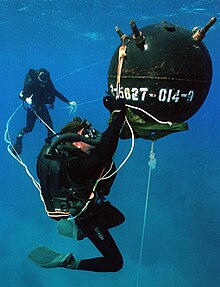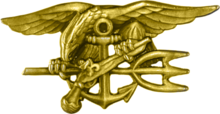Gun divers

Gun divers are military divers who, as specialized units, perform special tasks within the armed forces of a country. Due to their excellent training, these elite units are used in a wide variety of ways, also and especially in the run-up to military conflicts in reconnaissance and covert operations . Gun divers are trained and deployed in almost every country that maintains naval forces.
Segregation of duties and duties
A division of the weapon divers into different application series takes place in Germany , in the United Kingdom and in France , in the other countries a versatile application is given preference at the expense of a specialization.
Mine divers
- Disposal of ordnance on water and on land, in particular the disposal of explosive devices attached to ship hulls and underwater systems by the enemy
- Search, classification and disposal or recovery of underwater weapons such as sea mines or explosive devices in the water
- Operating underwater drones
- Rescue and recovery operations
Combat swimmers
- operational reconnaissance behind enemy lines in remote surveillance operations in coastal areas
- Attack against enemy ports and roads (especially against non-moving ships), locks, other port facilities and bridges
- Attack against targets of outstanding importance on land such as command and communication facilities, especially in the opposing coastal area
- Rescuing hostages
The special operations can be carried out as part of multinational operations.
equipment
The use of combat swimmers and mine divers differs significantly in terms of equipment, due to different tasks.
For mine divers, either compressed air or mixed gas devices are used. In oxygen-circuit devices , the depth is limited to 6 meters, which also when in compressed air diving equipment scuba diving be used, 50 meters. In mixed gas devices with Trimix , the oxygen content is reduced according to the depth, so diving depths of more than 54 meters can be reached.
Apart from the mechanical and electronic special tools, equipment parts are used by mine divers, as they are also part of civil diving equipment .
Gun divers in different countries
Germany
In Germany, in October 1991, the combat swimmer company and the mine diving company were merged to form a weapon diving group. This was incorporated into the flotilla of the mine forces . As of July 1, 2003, both units were separated and the Marine Specialized Forces (SEK M) . assumed.
Since 2002, the mixed gas diving device "FGT" has been replaced by a closed, computer-controlled, mixed-gas circuit diving device, the "Stealth EOD-M" from Divex in the German Navy .
United States

The training takes place in the following steps:
- Entry: General military basic training at the Recruit Training Command, Great Lakes , Illinois and grade training " Indoctrination " (5 weeks)
- Phase 1 (basic fitness training, 8 weeks)
- After 3 weeks of preparation, the “hell week” takes place, in these 5½ days you sleep a maximum of 4 hours a day, the rest of the time you train non-stop. In the remaining 4 weeks knowledge in the area of hydrographic surveying, sea charts and navigation is imparted.
- Phase 2 (diving, 8 weeks)
- Intensification of strength and conditioning training
- Swimming and diving training with compressed air and circulation devices
- Long-distance dives, boat training and training with underwater vehicles such as the SDV ( SEAL Delivery Vehicle )
- Combat swimmer training, underwater transport
- Phase 3 (land fight, 9 weeks)
- Gun training, demolition training and tactical training. Building fitness training with long-distance runs and shorter time limits for running routes , swimming routes and obstacle courses. Orientation on land and combat training. In the last 3½ weeks, the knowledge acquired will be applied on San Clemente Island .
- Skydiving training (3 weeks)
- Naval combat classification
- SEAL Qualification Training (15 weeks)
- Handing out the SEAL badge
- Advanced training (18 months) as a member of a SEAL team or SDV team, in which there are no assignments
- Use as a member of a SEAL team or SDV team
United Kingdom
Before the actual selection, applicants must complete a two-week course, which is divided into boating and diving weeks. In the first week they have to: take a general fitness test, swim 600 meters in 15 minutes, swim 50 meters in full uniform and with a gun, dive 25 meters and prove their skills with a paddle boat and march 5 kilometers with a canoe and backpack and paddle 30 kilometers. In the second week, various dives must be carried out and the basic ability and willingness to dive must be demonstrated.
They then go through the same selection process as the applicants for the Special Air Service (SAS). Only after they have qualified for the SAS can soldiers begin the further Special Boat Service (SBS) selection, which is already part of the training. It is naturally designed to take away the fear of the element water and lasts eight weeks. During this time, so-called swimming and canoeing training (SC3) must be completed. This includes navigation and fighting underwater, underwater training in explosives, exploring landing zones from the water, handling boats - which also includes a 55-kilometer march with a paddle boat - and penetrating enemy territory using small U. -Boating . Survival training in Scotland is also part of this course, as is diving in cold water with no aids and no sight and swimming. The soldiers are then members of the SBS with the rank of "Swimmer Canoeist Class 3" (SC3).
In some cases, the training takes place together with the SAS. Above all, the training in anti-terror tactics and that in general military skills are completed together.
They are then allowed to wear the symbol “SC” for this special training on the left cuff of their uniform. These and the parachute jump badge on the right arm are the only indications of their affiliation with the SBS. They wear the same uniforms and green berets as all Royal Marines . You will be assigned to one of the task forces and begin the actual training, during which you will continue to develop into specialists in various areas:
- First aid
- communication
- Counter-Terrorism Operations
- Languages etc.
Like the SAS, officers serve in the SBS for a maximum of three years, after which they are transferred back to the Royal Marines or the Royal Navy .
See also
- Combat swimmers
- Mine diving company
- Combat swimmer (Bundeswehr)
- Combat swimmer (Kriegsmarine)
- United States Navy SEALs
- Special boat service
- Frømandskorpset
- Commando Hubert
- Comando Subacquei ed Incursori (COMSUBIN)
Individual evidence
- ↑ Die Waffentaucher der Deutsche Marine , accessed on November 4, 2013.
- ^ Bundeswehr location database. Military History Research Office, Potsdam, accessed on February 12, 2014 .
- ^ Bundeswehr location database. Military History Research Office, Potsdam, accessed on February 12, 2014 .



